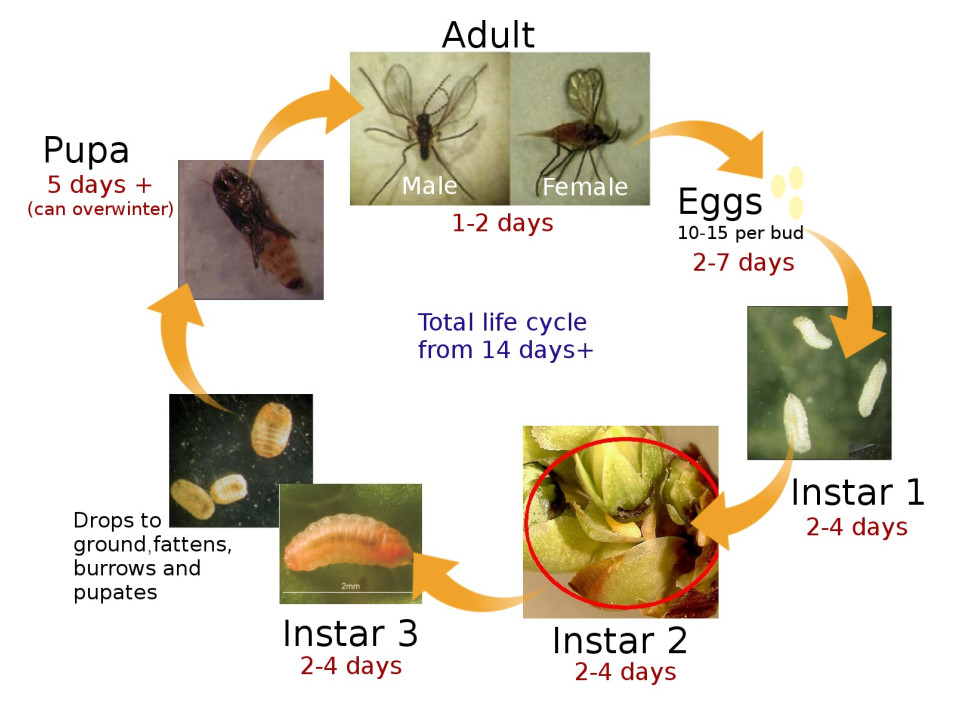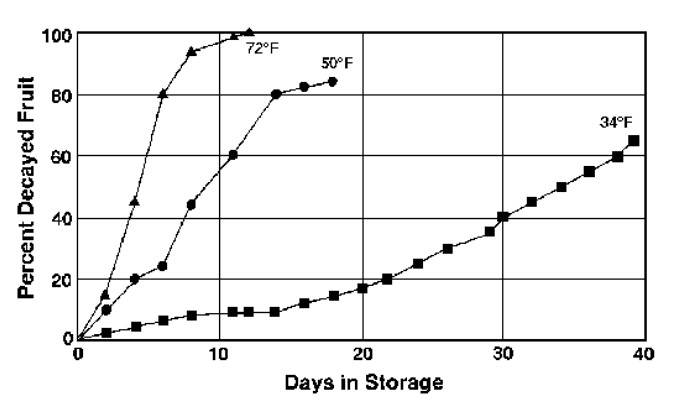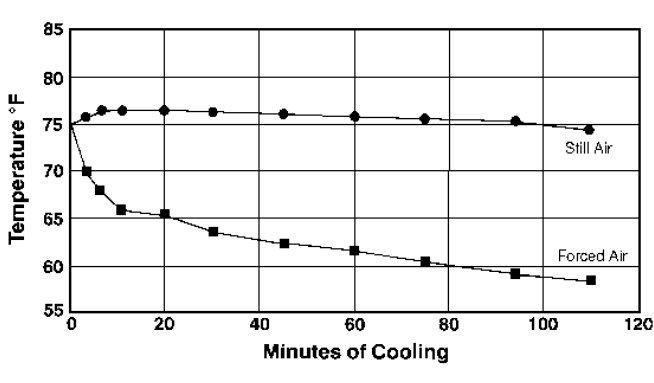Pete Jorgensen
Plant Science & Horticulture
Blueberry Production
Global blueberry production exceeded 1 billion pounds in weight in 2012 - an increase of over 30% from 2010. Commercial blueberry crops are made up from numerous different species of Vaccinium but the majority are varieties of highbush - Vaccinium corymbosum L. (Jackson et al., 2011). Market growth is significant, sustained, and predicted to continue. In 2017, the USA was the world’s largest producer of blueberries, harvesting 239,071 tonnes (Horti Daily, 2016). EU market growth between 2010 and 2014 was over 20% per annum (Agriculture and Agri-Food Canada, 2016). The value of the blueberry market in the UK was estimated at £237 million per annum with over 25 thousand tonnes sold in 2015 (McCallum & Graham, 2016). Producers have significant issues to overcome if they are to continue to meet demand and compete in a global market.
Blueberry Gall Midge (Dasineura oxycoccana)
Blueberry gall midge (BGM) is associated with between 20 and 80% crop loss (Sampson et al., 2002) but can cause 100% crop loss in some cultivars (Northwest Berry Foundation, 2016). In some areas in northern America, occurrences of BGM infestation are increasing (Sial, 2016). BGM has nearly eliminated the Rabbitteye V. ashei Reade blueberry industry in Florida (Florida blueberry, 2015). The insect is native to North America but has spread across the globe wherever blueberries are cultivated – most likely on nursery stock (Roubos & Isaacs, 2013). It was first discovered on the European continent in 1996 (in Italy); the first reported infestation in the UK was in 2008 (Collins & Eyre, 2010¹). Further occurrences were discovered in nurseries and production sites following an investigation in 2009 including two sites in Lancashire (Collins & Eyre, 2010). Dasineura oxycoccanaPage 2 of 11 may also affect cranberry (Vaccinium microcarpum (Turcz. ex Rupr.) Schmalh.) in which case it is often called tip worm. Recent research has identified that despite identical appearance the cranberry tip worm is, in fact, genetically distinct, and the two species do not interbreed (Cook et al., 2011; Mathur et al., 2012). This would suggest that infestations of cranberry would not pose a risk to blueberry crops. However, overlapping phenology can allow for quick genetic adaptation and species plasticity, so there is still a real risk of cross crop contamination that producers and nursery owners should be aware of (Cook et al., 2012).

Dasineura oxycoccana life cycle. (Cranshaw, 2015; Roubos, 2009; Roubos & Isaacs, 2013; Collins & Eyre, 2010¹; Collins & Eyre, 2010²; Yang, 2005; Turner & Liburd, 2007).
Infestations occurring in North American highbush varieties had a much more significant effect on reduction in flower bud numbers in August than those occurring in June and July (Hahn & Isaacs, 2015). The climate in which crops are grown appears to be highly relevant to the area of damage. In cooler climates, when flower buds emerge later, damage tends to be contained to leaf buds. In warmer climates, the flower buds can suffer significant damage (Collins & Eyre, 2010¹). The difference in feeding pattern may affect pest management decisions when balanced with prospective economic loss.
When damage is focussed on leaf buds, current season’s crop losses may not be of concern. However, the damage caused can contribute to undesirable future plant growth patterns, and may cause issues with cropping and harvest in future seasons (Modern Agriculture, 2017). Higher fruit to leaf ratios affect both the quality and size of the fruit, and it's a more significant factor than soil nutrient levels (Kader, 2011). Leaf bud damage is therefore best avoided. The midge life cycle has not been properly studied in UK conditions and scientific studies predominantly originate from North America (Collins & Eyre, 2010¹).
Within Europe, blueberry gall midge isn't a prolific pest, likely due to lower levels of production. As output increases within Europe, the importance of the threat will become increasingly salient (Plažanin et al., 2012). Pheromone traps are available in the UK for monitoring purposes (Agralan, 2014). Modern Agriculture (2017) stated that industry standard control thresholds had not yet been established but AHDB (2016) recommended a threshold of 10 males per pheromone trap to trigger pest control measures.
In the absence of traps, symptomatic damage should alert growers of the pest's presence. This may include leaf curl, short deformed growth, and necrotic tips (Modern Agriculture, 2017). When damage occurs at branch tips, witches broom may be observed, along with abnormal lower branching (Hollingsworth, 2016). Suspected infestations can be tested by taking sample buds and keeping them in a bag at room temperature – larvae should appear within 2-4 days (Collins & Eyre, 2010¹).
Once an infestation is identified, there are several measures that can be taken. Control of diapausing pupae can be achieved by shallow disking in late autumn or early winter, and a layer of sand may prevent adult emergence in spring (Collins & Eyre, 2010¹). Biological controls are limited (Collins & Eyre, 2010¹), but parasitic wasps have potential; they lay eggs in the midge larvae, and the hatchlings eat them alive (Roubos & Isaacs, 2013, Sampson et al., 2002). Pesticides should be used with caution to allow natural predators to thrive (Roubos, 2009).
A parasitoid, Aprostocetus, may be effective for controlling blueberry gall midge populations. Using an integrated pest management plan that includes it can reduce gall midge on blueberry crops by 85-100% (Sampson, 2013). Insecticides should not be used while pollinators are active; this will seriously threaten crop yields. They are often ineffective anyway because the midge eggs and larvae are protected by the bud (Gough & Korcak, 1995). Gall midge populations recover quickly following insecticide application because it usually wipes out their natural predators. Other methods of control are preferable. Further research on the phenology of the gall midge may assist development of better control methods.
Post Harvest Freshness
Crop production is the first hurdle for producers. The second major issue is getting the harvested produce to market in good saleable condition. Fresh blueberries fetch higher prices than their processed counterparts; correct postharvest treatment is essential in ensuring maximum returns for producers (Marzolo, 2015). It can take less than 12 hours for blueberries to begin to show signs of rot in suboptimal conditions (Boyette et al., 2014), and they are considered to have a high relative perishability rating when compared with other fruit crops (Lichtfouse, 2015).
Maintaining low temperatures in postharvest storage is standard commercial practice. It slows the metabolism and respiration rates of the berries, delaying senescence (Gutierrez, 2014). A temperature of 0°C combined with 90-95% relative humidity can extend post-harvest life-span from anywhere between 2-6 weeks (Considine, 1982; Bachmann & Earles, 2000). Fast chilling techniques are recommended. Forced air cooling, using fans, is 4-10 times quicker than static air cooling (Schilder, 2011; Kahlke, 2015).

The influence of temperature on the decay of blueberries while in storage (Boyette et al., 2014).

Forced air cools blueberries much faster than still air (Boyette et al., 2014).
Reduced temperatures help maintain general quality, but some fungal infections can still develop at 0°C in conditions of high humdity (Forney, 2009). Following success with other berry fruits blueberry producers often use modified atmosphere packaging (MAP) to extend the life of the crop, and maintain marketability and appearance (Gutierrez, 2014). The packing atmosphere is altered by increasing the concentration of CO₂ to 15-20%, and reducing the O₂ ratio to 5-10% (Gutierrez, 2014; DeEll, 2005). This decreases the activity levels of microorganisms – particularly Botrytis cinerea.
MAP packaging is completely sealed. It can be used for consumer packaging, or full pallet wraps for transportation (Gutierrez, 2014; DeEll, 2005). Other forms of packaging have vent holes to allow gaseous exchange, cooling, and the escape of moisture (Watson et al., 2015). Consumers are becoming increasingly aware of environmental concerns over plastic use. Sealed containers made from biodegradable polylactide containers may permit the use of MAP, and be less polluting (Almenar et al., 2008). The use of ozone (0₃) in controlled atmosphere storage (CAS) reduces weight loss and maintains a higher firmness index (Concha-Meyer et al., 2015).
Other tested post-harvest treatments include the use of a layer of sucralose (Loyola López et al., 2016), and UV-C radiation was (Perkins-Veazie et al., 2008). Berry friendly mechanization, to reduce post harvest handling damage, also extends the life of crops (Wooten, 2015).
References and further reading
Agralan, 2014. New for 2014: Blueberry Midge Pheromone Trap. [Online]
Available at: http://www.agralan-growers.co.uk/latest-news-16-w.asp
[Accessed 19 March 2017].
Agriculture and Agri-Food Canada, 2016. Blueberries in the European Union. [Online]
Available at: http://www.agr.gc.ca/eng/industry-markets-and-trade/statistics-and-market-
information/agriculture-and-food-market-information-by-region/europe/market-
intelligence/blueberries-in-the-european-union/?id=1458052054506
[Accessed 28 February 2017].
AHDB, 2016. Science Into Practice - Blueberry gall midge control. [Online]
Available at: http://www.hortweek.com/science-practice-blueberry-gall-midge-control/fresh-
produce/article/1401198
[Accessed 28 March 2017].
Alexander, S., 2016. From preventing dementia to grey hair: why blueberries could be the best thing
to ever happen to you. [Online]
Available at: http://www.telegraph.co.uk/food-and-drink/news/healthy-reasons-to-eat-blueberries-
natures-superfood/
[Accessed 15 March 2017].
Almenar, E. et al., 2008. Postharvest shelf life extension of blueberries using a biodegradable
package. Food Chemistry, 110(1), pp. 120-127.
Argentinian Blueberry Committee, 2016. Postharvest of blueberries: still a lot to learn and work on.
[Online]
Available at: http://www.argblueberry.com/home/en/postcosecha-de-arandanos-un-proceso-en-el-
que-no-esta-todo-dicho/
[Accessed 19 March 2017].
Bachmann, J. & Earles, R., 2000. Postharvest handling of fruits and vegetables, s.l.: ATTRA.
Boyette, M. D., Estes, E. A., Mainland, C. M. & Cline, W. O., 2014. Postharvest Cooling and Handling
of. [Online]
Available at: https://www.bae.ncsu.edu/programs/extension/publicat/postharv/ag-413-7/
[Accessed 20 March 2017].
British Summer Fruits, 2012. Blueberries. [Online]
Available at: http://www.britishsummerfruits.co.uk/html/blueberries.htm
[Accessed 3 March 2017].
Collins, D. & Eyre, D., 2010¹. Blueberry gall midge: Dasineura oxycoccana, York: FERA.
Collins, D. & Eyre, D., 2010². FERA PLANT PEST FACTSHEET: Blueberry gall midge. [Online]
Available at: http://www.hortweek.com/fera-plant-pest-factsheet-blueberry-gall-midge-dasineura-
oxycoccana/fresh-produce/article/1021351
[Accessed 10 March 2017].
Concha-Meyer, A. et al., 2015. Shelf life determination of fresh blueberries (Vaccinium corymbosum)
stored under controlled atmosphere and ozone. International journal of food science, Volume 2015.
Considine, D. M., 1982. Foods and Food Production Encyclopedia. 1st ed. New York: Van Nostrand.
Cook, M. A., Fitzpatrick, S. M. & Roitberg, B. D., 2012. Phenology of Dasineura oxycoccana (Diptera:
Cecidomyiidae) on Cranberry and Blueberry Indicates Potential for Gene Flow. Journal of economic
entomology, 105(4), pp. 1205-1213.
Cook, M. A., Ozeroff, S. N., Fitzpatrick, S. M. & Roitberg, B. D., 2011. Host‐associated differentiation
in reproductive behaviour of cecidomyiid midges on cranberry and blueberry. Entomologia
experimentalis et applicata, 141(1), pp. 8-14.
Cranshaw, W., 2015. Garden Insects of North America: The Ultimate Guide to Backyard Bugs. 1st ed.
Princeton: Princeton University Press.
Cutler, C., Sproule, J. & Lynch, K., 2011. Blueberry Gall Midge, Nova Scotia: Nova Scotia Agricultural
College.
DeEll, J., 2005. Postharvest Handling and Storage of Berries. [Online]
Available at: http://www.omafra.gov.on.ca/english/crops/facts/storage_berries.htm
[Accessed 24 March 2017].
DOW, 2017. Success Naturalyte Insect Control. [Online]
Available at:
http://msdssearch.dow.com/PublishedLiteratureDAS/dh_094c/0901b8038094cbd6.pdf?filepath=/n
oreg&fromPage=GetDoc
[Accessed 01 March 2017].
Florida blueberry, 2015. Pest Management. [Online]
Available at: http://floridablueberrygrowers.com/grower/growers-resources/
[Accessed 26 March 2017].
Forney, C. F., 2009. Postharvest issues in Blueberry and Cranberry and Methods to Improve Market
Life. Acta horticultura, 810(2009), pp. 785-798.
Fresh Fruit Portal, 2013. Blueberry production could rise 50% by 2018, but will that be enough?.
[Online]
Available at: http://www.freshfruitportal.com/news/2013/04/01/blueberry-production-could-rise-
50-by-2018-but-will-that-be-enough/
[Accessed 03 21 2017].
Gough, R. E. & Korcak, R. F., 1995. Blueberries - A century of research - part 1. 1st ed. New York: The
Haworth Press.
Gutierrez, C., 2014. Blueberries of the world 2014, Santiago: Fresh Fruit Portal.
Hahn, N. G. & Isaacs, R., 2012. Distribution and Phenology of Dasineura oxycoccana
(Diptera:Cecidomyiidae) in Michigan Blueberries. Environmental Entomology, 41(3), pp. 455-462.
Hahn, N. G. & Isaacs, R., 2015. Assessing the Economic Importance of Dasineura oxycoccana
(Diptera: Cecidomyiidae) in Northern Highbush Blueberries. Journal of Economic Entomology, 108(4),
pp. 1910-1914.Page 9 of 11
Hollingsworth, C. S., 2016. PNW Insect Management Handbook. 4th ed. Corvallis: Oregan State
University.
Horti Daily, 2016. World's top ten blueberry producing countries. [Online]
Available at: http://www.hortidaily.com/article/26165/Worlds-top-ten-blueberry-producing-
countries
[Accessed 18 March 2017].
Huang, L. & Yu, J., 2016. Effects of blueberry anthocyanins on retinal oxidative stress and
inflammation in diabetes through Nrf2/HO-1 signaling. Journal of Neuroimmunology, 301(2016), pp.
1-6.
Jackson, D., Looney, N. E. & Morley-Bunker, M., 2011. Temperate and Subtropical Fruit Production.
3rd ed. Wallingford: CABI.
Kader, A. A., 2011. Postharvest Technology of Horticultural Crops. 3rd ed. Richmond: University of
California.
Kahlke, C., 2012. Blueberry Harvest & Postharvest Handling 2012, Ithaca: Cornell University.
Kahlke, C., 2015. Postharvest Care to Enhance Blueberry Crop Value, Ithaca: Cornell Cooperative
Extension.
Kozai, T., Niu, G. & Takagaki, M., 2016. Plant Factory: An indoor vertical farming system for efficient
food quality production. 1st ed. Oxford: Elsevier.
Lichtfouse, E., 2015. Postharvest Management of Fruits. 15th ed. New York: Springer.
Loyola López, N., Aguirre Poblete, F., Godoy Astudillo, O. & Arriola Herrera, M., 2016. Effect of
sucralose and biostimulant on pre-and postharvest of blueberries (Vaccinium corymbosum L. cv.
Elliot) under organic and conventional production systems.. Acta Agronómica, 65(2), pp. 123-129.
Mann, N. A., 2015. Intensive Berry Production Using Greenhouses, Substrates and Hydroponics.,
Woongarrah: Nuffield Australia.
Marzolo, G., 2015. Blueberries. [Online]
Available at: http://www.agmrc.org/commodities-products/fruits/blueberries/
[Accessed 25 March 2017].
Mathur, S., Cook, M. A., Sinclair, B. J. & Fitzpatrick, S. M., 2012. DNA barcodes suggest cryptic
speciation in Dasineura oxycoccana (Diptera: Cecidomyiidae) on cranberry, Vaccinium macrocarpon,
and blueberry, V. corymbosum. Florida Entomologist, 95(2), pp. 387-394.
McCallum, S. & Graham, J., 2016. Current blueberry developments and how they can translate
towards a UK cherry model, Invergowrie: The James Hutton Institute.
Modern Agriculture, 2017. Pest Profile: Blueberry Gall Midge. [Online]
Available at: http://modernagriculture.ca/pest-profile-blueberry-gall-midge/
[Accessed 17 March 2017].
NHS Choices, 2015. Blueberries: antioxidant powerhouse?. [Online]
Available at: http://www.nhs.uk/Livewell/superfoods/Pages/are-blueberries-a-superfood.aspx
[Accessed 15 March 2017].Page 10 of 11
Northwest Berry Foundation, 2016. Management Detail: Blueberry Gall Midge. [Online]
Available at: http://www.nwberryfoundation.org/DisordersDetail.asp?id=90
[Accessed 8 March 2017].
Paniagua, A. C., East, A. R. & Heyes, J. A., 2014. Interaction of temperature control deficiencies and
atmosphere. Postharvest Biology and Technology, 95(2014), pp. 50-59.
Perkins-Veazie, P., Collins, J. K. & Howard, L., 2008. Blueberry fruit response to postharvest
application of ultraviolet radiation. Postharvest Biology and Technology, 47(3), pp. 280-285.
Plažanin, M., Čuljak, T. G. & Juran, I., 2012. Blueberry gall midge, Dasineura oxycoccana Johnson,
1899 (Diptera: Cecidomyiidae), a new blueberry pest in Croatia. The Journal of Food, Agriculture and
Environment, 10(2012), pp. 521-526.
PostHarvest, 2017. UNITEC S.P.A.. [Online]
Available at: http://www.postharvest.biz/en/company/unitec-
spa/_id:29711,seccion:product_catalog,producto:10704/
[Accessed 26 March 2017].
Poulose, S. M. et al., 2017. Neurochemical differences in learning and memory paradigms among
rats supplemented with anthocyanin-rich blueberry diets and exposed to acute doses of 56Fe
particles. Life Sciences in Space Research, 12(February), pp. 16-23.
RHS, 2017. Withdrawn insecticides and animal repellents. [Online]
Available at: https://www.rhs.org.uk/Advice/Profile?PID=820
[Accessed 15 March 2017].
Roubos, C. R., 2009. Monitoring and managing blueberry gall midge (Diptera: cecydomyiidae) in
rabbiteye blueberries, Florida: University of Florida.
Roubos, C. R. & Isaacs, R., 2013. Blueberry Gall Midge, Michigan: Michigan State University.
Sampson, B. J., 2013. Biology and efficacy of Aprostocetus (Eulophidae: Hymenoptera) as a
parasitoid of the blueberry gall midge complex: Dasineura oxycoccana and Prodiplosis vaccinii
(Diptera: Cecidomyiidae).. Journal of economic entomology, 106(1), pp. 73-79.
Sampson, B. J., Stringer, S. J. & Spiers, J. M., 2002. Integrated pest management for Dasineura
oxycoccana (Diptera: Cecidomyiidae) in blueberry. Environmental entomology, 31(2), pp. 339-347.
Sampson, B. J., Stringer, S. J. & Spiers, J. M., 2002. Integrated Pest Management for Dasineura
oxycoccana (Diptera: Cecidomyiidae) in Blueberry. Environmental entomology, 31(2), pp. 339-347.
Schilder, A., 2011. Control of pre- and post-harvest fruit rots in blueberries. [Online]
Available at:
http://msue.anr.msu.edu/news/control_of_pre_and_post_harvest_fruit_rots_in_blueberries
[Accessed 18 March 2017].
Seasonal Berries, 2017. Blueberries. [Online]
Available at: http://www.seasonalberries.co.uk/2011/08/berry-seasonal-
information/blueberries.html
[Accessed 15 March 2017].Page 11 of 11
Sial, A., 2016. Monitoring and Management of Blueberry Gall Midge. [Online]
Available at: http://blog.caes.uga.edu/blueberry/2016/03/blueberry-gall-midge-2/
[Accessed 7 March 2017].
Song, J. et al., 2010. Effect of hexanal vapor to control postharvest decay and extend shelf-life of
highbush blueberry fruit during controlled atmosphere storage. Canadian Journal of Plant Science,
90(3), pp. 359-366.
Turner, J. C. L. & Liburd, O. E., 2007. Insect management in blueberries in the eastern United States,
Florida: Dept. of Entomology and Nematology, Florida Cooperative Extension Service, Institute of
Food and Agricultural Sciences, University of Florida.
U.S. Highbush Blueberry Council, 2013. Blueberry Nutrition. [Online]
Available at: http://www.blueberrycouncil.org/blueberry-nutrition/
[Accessed 20 March 2017].
U.S. Highbush Blueberry Council, 2014. Global Production. [Online]
Available at: http://www.blueberrycouncil.org/blueberry-marketers/
[Accessed 16 March 2017].
University of Florida, 2017. Common name: blueberry gall midge: Scientific name: Dasineura
oxycoccana (Johnson) (Insecta: Diptera: Cecidomyiidae). [Online]
Available at: http://entnemdept.ufl.edu/creatures/fruit/blueberry_gall_midge.htm
[Accessed 15 March 2017].
University of Hertfordshire, 2016. Pesticide Properties Database. [Online]
Available at: http://sitem.herts.ac.uk/aeru/bpdb/Reports/596.htm
[Accessed 12 March 2017].
Watson, J. A. et al., 2015. Postharvest Storage, Packaging and Handling of Specialty Crops, Florida:
University of Florida.
Wooten, M., 2015. A little TLC could help in harvesting blueberries. [Online]
Available at: http://www.uga.edu/about_uga/profile/a-little-tlc-could-help-blueberry-harvesting/
[Accessed 18 March 2017].
Yang, W. Q., 2005. Blueberry Gall Midge:A possible new pest in the Northwest, Corvallis: Oregon
State University.